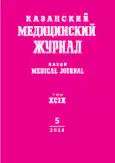Development of secondary mitochondrial dysfunction of mononuclear blood leukocytes in patients with chronic obstructive pulmonary disease and chronic bronchitis
- Authors: Bel’skikh ES1, Uryas’ev OM1, Zvyagina VI1, Faletrova SV1
-
Affiliations:
- Ryazan State Medical University n.a. academician I.P. Pavlov
- Issue: Vol 99, No 5 (2018)
- Pages: 741-747
- Section: Theoretical and clinical medicine
- URL: https://bakhtiniada.ru/kazanmedj/article/view/10295
- DOI: https://doi.org/10.17816/KMJ2018-741
- ID: 10295
Cite item
Full Text
Abstract
Aim. To study the indicators of energy metabolism and oxidative stress in mononuclear leukocytes of peripheral blood and to assess the possibility of mitochondrial dysfunction development in chronic obstructive pulmonary disease and chronic bronchitis.
Methods. The study included 50 patients aged 40 to 75 years with chronic obstructive pulmonary disease (COPD) or chronic bronchitis. The first group included 13 patients with chronic bronchitis. In accordance with the GOLD spirometric classification, the second and third groups included patients with COPD of moderate severity (COPD 2) (n=17) and severe COPD (COPD 3) (n=20) respectively. In the isolated mononuclear leukocytes, the activity of superoxide dismutase (SOD), succinate dehydrogenase (SDH) and concentration of succinate were determined, a complex evaluation of oxidative modification of proteins was performed.
Results. Patients with chronic bronchitis compared to patients with COPD 2 and COPD 3 were found to have in mononuclear leukocytes higher activity of SOD by 3.38 times (p=0.0025) and 3.15 times (p=0.0058), higher activity of SDH by 4.55 times (p=0.0281) and 2.5 times (p=0.0263) and higher succinate concentration by 2.05 (p=0.0133) and 1.89 (p=0.005) times respectively. The level of spontaneously oxidized modified proteins in the group of patients with chronic bronchitis decreased by 2.45 (p=0.0176) and 2.94 (p=0.0168) times compared to the patients of groups 2 and 3, respectively There was a decrease in the reserve-adaptive potential of oxidative modification of proteins in COPD in the form of an increase of the ratio of spontaneously oxidized-modified proteins to metal-induced oxidized proteins by 1.58 times (p=0.0301) between groups 1 and 2, and by 1.44 times between groups 2 and 3 (p=0.0446).
Conclusion. In mononuclear leukocytes of COPD patients, secondary mitochondrial dysfunction is observed accompanied by significant oxidative damage of lymphocytes and monocytes. Patients with severe COPD compared to patients with COPD of moderate severity have less reserve-adaptive potential for the oxidative modification of mononuclear leukocyte proteins, which probably reflects a more severe course of the disease.
Full Text
##article.viewOnOriginalSite##About the authors
E S Bel’skikh
Ryazan State Medical University n.a. academician I.P. Pavlov
Author for correspondence.
Email: ed.bels@yandex.ru
Ryazan, Russia
O M Uryas’ev
Ryazan State Medical University n.a. academician I.P. Pavlov
Email: ed.bels@yandex.ru
Ryazan, Russia
V I Zvyagina
Ryazan State Medical University n.a. academician I.P. Pavlov
Email: ed.bels@yandex.ru
Ryazan, Russia
S V Faletrova
Ryazan State Medical University n.a. academician I.P. Pavlov
Email: ed.bels@yandex.ru
Ryazan, Russia
References
- GOLD 2018 Global Strategy for the Diagnosis, Management and Prevention of COPD. Available at: http://goldcopd.org/wp-content/uploads/2017/11/GOLD-2018-v6.0-FINAL-revised-20-Nov_WMS.pdf
- Agrawal A., Mabalirajan U. Rejuvenating cellular respiration for optimizing respiratory function: targeting mitochondria. Am. J. Physiol. Lung Cell. Mol. Physiol. 2016; 310 (2): 103–113. doi: 10.1152/ajplung.00320.2015.
- Brand M.D., Nicholls D.G. Assessing mitochondrial dysfunction in cells. Biochem. J. 2011; 437 (3): 297–312. doi: 10.1042/BJ4370575u.
- Gayan-Ramirez G., Decramer M. Mechanisms of striated muscle dysfunction during acute exacerbations of COPD. J. Appl. Physiol. 2013; 114 (9): 1291–1299. doi: 10.1152/japplphysiol.00847.2012.
- Lerner C.A., Sundar I.K., Rahman I. Mitochondrial redox system, dynamics, and dysfunction in lung inflammaging and COPD. Int. J. Biochem. Cell Biol. 2016; 81: 294–306. doi: 10.1016/j.biocel.2016.07.026.
- Hoffmann R.F., Zarrintan S., Brandenburg S.M. et al. Prolonged cigarette smoke exposure alters mitochondrial structure and function in airway epithelial cells. Respir. Res. 2013; 14 (1): 97. doi: 10.1186/1465-9921-14-97.
- Zinellu E., Zinellu A., Fois A.G. et al. Circulating biomarkers of oxidative stress in chronic obstructive pulmonary disease: a systematic review. Respir. Res. 2016; 17 (1): 150. doi: 10.1186/s12931-016-0471-z.
- Lukyanova L.D., Kirova Y.I. Mitochondria-controlled signaling mechanisms of brain protection in hypoxia. Front. Neurosci. 2015; 9: 320. doi: 10.3389/fnins.2015.00320.
- Fomina M.A., Abalenikhina Yu.V. Okislitelʹnaya modifikatsiya belkov tkaney pri izmenenii sinteza oksida azota. (Oxidative modification of tissue proteins by changing the synthesis of nitric oxide.) Moscow: GEOTAR-Media. 2018; 192 p. (In Russ.)
- Fomina M.A., Abalenikhina Yu.V. Sposob kompleksnoy otsenki soderzhaniya produktov okislitelʹnoy modifikatsii belkov v tkanyakh i biologicheskikh zhidkostyakh: metodicheskie rekomendatsii. (A method for the complex estimation of the content of products of oxidative modification of proteins in tissues and biological fluids: methodological recommendations.) Ryazan: RIO RyazGMU. 2014; 60 p. (In Russ.)
- Li L A., Lebed’ko O.A., Kozlov V.K. Assessment of mitochondrial dysfunction in children with community-acquired pneumonia. Dal’nevostochnyy meditsinskiy zhurnal. 2015; 2: 30–36. (In Russ.)
- Kostyuk V.A., Potapovich A.I., Kovaleva Zh.V. A simple and sensitive method of determination of superoxide dismutase activity based on the reaction of quercetin oxidation. Voprosy meditsinskoy khimii. 1990; 36 (2): 88–91. (In Russ.)
- Metody biokhimicheskikh issledovaniy (lipidnyy i ehnergeticheskiy obmen). (Methods of biochemical research (lipid and energy metabolism). Ed. by Prokhorova M.I. Leningrad: Izdatel’stvo Leningradskogo universiteta. 1982; 327 p. (In Russ.)
Supplementary files






